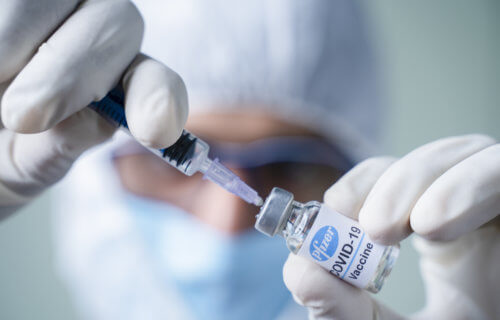LONDON — Although people receiving Pfizer’s version of the coronavirus vaccine will be getting two doses, a new report by the British government finds just one shot is having a profound impact on ending the pandemic. Researchers with Public Health England (PHE) find one dose of the Pfizer vaccine slashes the risk of death from COVID-19 by more than 75 percent.
The new report adds that the vaccine is also effective against the new “B.1.1.7” mutation that caused the virus to spread rapidly through south east London before Christmas. Early data shows the first shot reduces the risk of catching the virus by more than 70 percent. That protection goes up to 85 percent once patients receive their second shot.
PHE described the independent analysis, examining British healthcare workers, as “promising.” Researchers discovered “high levels of protection” after the first shot, with hospitalization and mortality rates dropping significantly in those receiving the Pfizer version.
“This is strong evidence that the Pfizer-BioNTech vaccine is stopping people from getting infected, while also protecting cases against hospitalization and death,” says Dr. Mary Ramsay, head of immunization at PHE, in a media release. “We will see much more data over the coming weeks and months but we should be very encouraged by these initial findings.”
Pfizer COVID vaccine improves protection for seniors
The testing data shows that one dose is 57 percent effective against symptomatic disease in adults over 80 years-old after about three to four weeks. A second dose improves protection in this group by another 30 percent, bringing total protection to 85 percent in seniors.
Hospitalization and deaths are falling in all age groups, but the oldest are seeing the fastest benefits since the new strain’s peak in mid-January. Study authors say the few vaccinated people who still go on to become infected with COVID are far less likely to die or need hospitalization.
The risk of dying in those over 80 years-old is 56 percent lower 14 days after receiving the first vaccine dose. Moreover, those who develop infection afterwards are around 40 percent less likely to need hospitalization than someone who did not receive the vaccine.
Although the initial results are promising, PHE says they will continue to observe these trends closely over the coming months, as the vaccine is not a guarantee of total immunity.
“Protection is not complete, and we don’t yet know how much these vaccines will reduce the risk of you passing COVID-19 onto others,” Dr. Ramsay says. “So even if you have been vaccinated, it is really important that you continue to act like you have the virus, practice good hand hygiene and stay at home.”
Other vaccines may be just as effective
PHE is also monitoring the impact of the AstraZeneca vaccine and will publish these findings in due course. Early signs suggest it is providing good levels of protection from its first dose as well.
There is also good evidence suggesting that giving the second dose of AstraZeneca later will lead to much higher levels of protection. Offering the booster at twelve weeks will therefore help to ensure longer lasting protection beyond the current restrictions.
“This crucial report shows vaccines are working – it is extremely encouraging to see evidence that the Pfizer vaccine offers a high degree of protection against coronavirus,” Health Secretary Matt Hancock says.
“Vaccines save lives, and so it is vital we roll out the vaccine program as fast as possible, and that as many people as possible take the jab. This new evidence shows that the jab protects you, and protects those around you. It is important that we see as much evidence as possible on the vaccine’s impact on protection and on transmission, and we will continue to publish evidence as we gather it. As we roll out the jab, it is vital people continue to play their role in protecting the NHS by sticking with the rules.”
The SIREN (Sarscov2 Immunity & REinfection EvaluatioN) study involved a sample of healthcare workers undertaking symptom questionnaires, respiratory swabs, and serum samples.
SWNS writer Mark Waghorn contributed to this report.
